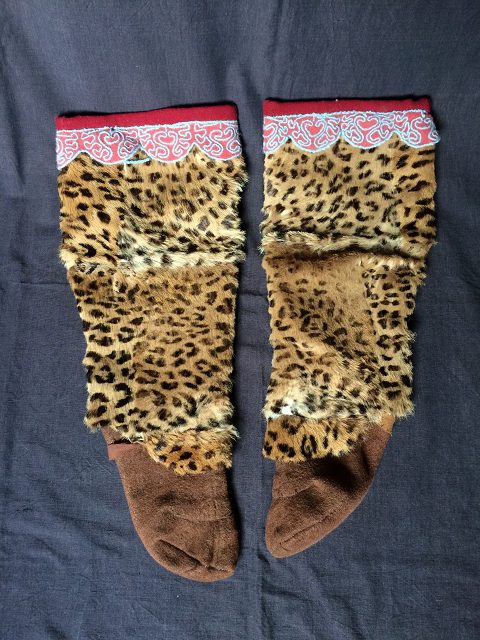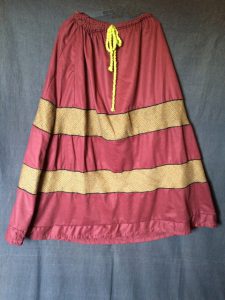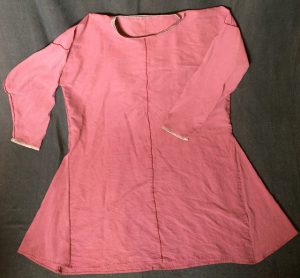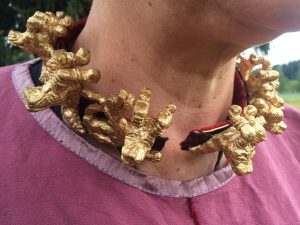Equipment Nomadic Elite at the Altai
 Unless otherwise stated, the objects shown are reproductions of the original state. If features such as color, object parts etc. were added by us, it is noted.
Unless otherwise stated, the objects shown are reproductions of the original state. If features such as color, object parts etc. were added by us, it is noted.
[peg]
 Boots
Boots
The comparatively short boots were only 25 cm high and decorated with leopard fur on the outside. The dark vamp at the feet was folded in the front and sewed to the shaft by means of a red woolen band. The sole was sewn and embellished with a floral pattern in corded embroidery, with remnants of tin foil and gold foil.
To make the garment practical for our purposes, we will work sock and shoe separately.
Rudenko 1970: 95f., Pl. 155D.
Polos’mak und Barkova 2005: 96.
 Bag
Bag
There are only a few pocket-finds in the milieu of Eurasian nomads, but some remains have been preserved in the permafrost tombs of the Pazyryk culture. An interesting construction was found in Pazyryk II. Two pocket covers enclosed a bag of soft leather inside, with coriander seeds. Both leather covers could be pulled together by a narrow strap, thus closing the sewn-on bag. On the outside a leopard fur was attached (which we have replaced with a dyed rabbit fur) and a hem was made of red felt. On it little copper plaques were sewn, which were gilded.
read on...Rudenko 1970: 75f., Pl. 153A.
 Skirt
Skirt
To the feminine touch of the Pazyryk culture belonged long skirts worn under the shirt. They were composed of different strips of fabric, as well as the skirt from the second Kurgan of Pazyryk, which consisted of red and patterned textile segments.
read on...
Polos’mak und Barkova 2005: 62-67.
Sembach und von Haeseler 1984: 194f.
 Hat
Hat
Pointed and high headgears have a long tradition at scythian nomadic tribes, and they occur in the east of the steppes, again and again, in the context of richly equipped tombs, also in the case of the “Ukok-Princess” [Link]. The hat shown here was first misinterpreted as a sock. It was made of felt, originally of a dark red color and over 80 cm long. On the brim were small slices of gilded leather.
read on...
Polos’mak und Barkova 2005: 76.
Rudenko 1970: 93-96.
 Silk Shirt
Silk Shirt
In the permafrost graves of the Pazyryk culture, various shirts were found in men’s and women’s made either of hemp or silk. They always show a similar appearance, as the seams and, to a large extent, the seams are covered with piping and braids. The dimensions of our silk shirt are taken from an original from Pazyryk, while the color design is not based on a find, but would have been possible taking into account the colorants customary in the Altai Mountains.
read on...Rudenko 1970: 83-85.
Polos’mak und Barkova 2005: 69-71.
 Belt with Cocks
Belt with Cocks
In Kurgan II of Pazyryk, a leather belt was found, on which leather applications featuring cocks were sewn. These were originally gilded. Two of the cocks are looking to the left, three to the right. Perhaps this object was the part of a belt as we use it. Other theories are based on the assumption that this may have been the part of the horse’s harness.
read on...Polos’mak und Barkova 2005: 49.
Sembach und von Haeseler 1984: 115.
Rudenko 1970: 100.
 Cordbelt
Cordbelt
The woman’s skirt from the Ukok plateau [Link] was held with a belt made of braided technique, with six tassels at the ends. Also for this equipment, we decided to build such a belt, and it was unexpectedly complicated to produce such a dense and complex fabric, as was the case with the original. However, a combination of different knitting and sewing techniques resulted in a satisfactory result.
read on...Polos’mak und Barkova 2005: 68.
 Choker
Choker
This choker is from Pazyryk II and, like many pieces of the Pazyryk culture, was mostly made of gilded wood. The six sculpturally fabled figures with wings and horns were attached to a hoop of gilded copper (we used brass instead), which opened in the front.
read on...Rudenko 1970: 107f.
